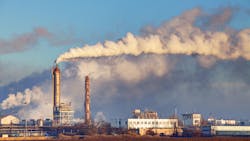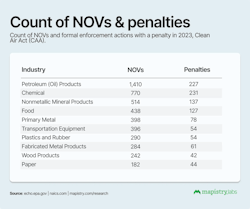Top Manufacturing Sector Offenders of Clean Air Act Compliance
A recent report on Clear Air Act (CAA) penalties from Mapistry, a software company in the EHS sector, delved into specific subsectors in manufacturing.
At the top of the list was petroleum products manufacturing which had 1,410 notices of violation (NOV) issued in 2023.
The number was almost twice as many as the chemical industry, which had 770 NOV.
With regard to penalties, the chemical industry received the most penalties (231), followed by oil (227).
In third place was the nonmetallic mineral products industry with 137 penalties - 40% fewer penalties than the top two.
Industries like computer and electronics, leather, and apparel manufacturing received the fewest NOVs relative to the number of businesses in their subsector.
The chart below shows the NOVs in other subsectors, as well as penalties.
The high penalty density and number of NOVs may be due to stringent regulatory scrutiny, inherent environmental risks, and the large scale of their operations, the report noted. Regulatory agencies might impose stricter compliance standards on high-risk industries due to their environmental impact, resulting in more inspections and enforcement actions.
However, the use of older technologies and less efficient processes in these industries can also play a significant role in contributing to higher rates of non-compliance.
Conversely, industries such as computer and electronics, leather, and apparel manufacturing may receive fewer NOVs relative to their size due to having lower environmental risks and less polluting processes, making compliance with environmental regulations easier.
The average CAA penalty in manufacturing has increased across the board
Rising penalties have been an ongoing story since the beginning of our Mapistry Labs series. From their first report, which analyzed penalties across all industries.
The primary metal industry led the pack with an average of $169,858, followed by the oil ($94,965) and chemical ($89,999) industries.
With a decrease of $24,449, the machinery industry saw the biggest decrease in penalty sizes. The lowest penalty payments were recorded in the textile product mills industry ($4,088).
Long-term penalty trends
The reporta lso examined long-term trends for the most frequently fined industries: primary metal, oil, chemicals, and paper.
The primary metal and chemical industries have seen a long-term increase in penalty sizes. In the chemical industry, the increase has been consistent except for one five-year period (2009-2013).
While the oil businesses received the absolute and relative NOVs and penalties, their penalty sizes have been much worse in the past, specifically between 1999 and 2008. The same holds true for the paper industry.

